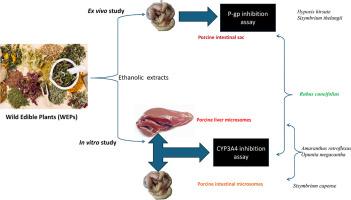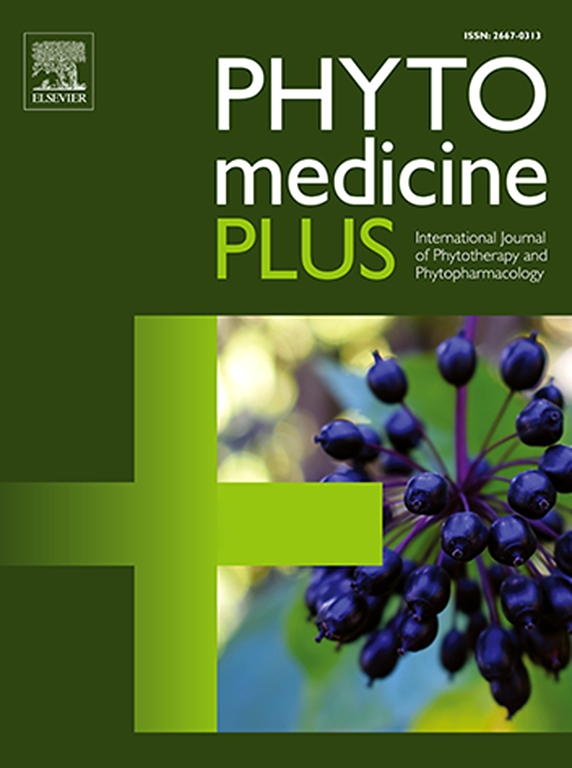通过体内外 p-糖蛋白和体外细胞色素 P450 3A4 抑制作用评估南部非洲野生食用植物与药物之间的潜在相互作用
Q3 Pharmacology, Toxicology and Pharmaceutics
引用次数: 0
摘要
背景包括草药在内的野生食用植物(WEPs)为非洲大陆的当地社区提供主食和收入。然而,这些常用的植物材料会通过抑制 p-糖蛋白(P-gp)和细胞色素 P450 酶与正统或传统药物相互作用。因此,在同时服用传统药物剂型和某些西药时,探讨草药与药物相互作用的可能性至关重要。P-gp 和 CYP3A4 具有类似的底物特异性,共同作用建立了异种生物的肠道吸收屏障。本研究调查了部分野生食用植物对体内 p-glycoprotein 的抑制作用和体外对细胞色素 P450 3A4 (CYP3A4)同工酶的抑制作用,以确定潜在的食物/草药相互作用。研究方法研究使用了来自莱索托、埃斯瓦提尼和南非林波波省的 30 种野生食用植物的乙醇提取物。在 95 % O2/5 % CO2 的环境下,使用肠囊与克雷布斯-林格碳酸氢盐缓冲液(pH 7.4)中的测试溶液进行了普萘洛尔(P-糖蛋白底物)通过猪肠组织的药物转运研究。在体外发光法 CYP3A4 抑制试验中,猪肝和肠道微粒体都是通过匀浆从各自组织中提取出来的,然后进行高速离心和标准化处理后再使用。05)抑制 P-gp,其有效表观渗透系数(Papp eff)为 (7.53±0.33) × 10-6 cm/s,有效通量(Jeff)为 1.38±0.01 µg/cm2/min ,与正钒酸钠(阳性对照)相似。此外,Rubus cuneifolius Pursh 和 Hypoxis hirsuta (L.) Coville 都有显著的 p-glycoprotein 抑制作用(p < 0.05),Papp eff 为 (6.60±0.52) × 10-6 cm/s,Jeff 为 1.11±0.08 µg/cm2/min ;Papp eff 为 6.58±0.67 × 10-6 cm/s,Jeff 为 1.19±0.12 µg/cm2/min。具有显著意义(p < 0.05)的是,浓度为 0.2 mg/mL 的楔叶茜草在肝脏微粒体中表现出最强的 CYP3A4 抑制作用,这表明它具有提高 CYP3A4 底物生物利用度的潜力。结论观察到的某些野生食用植物对 P-gp 介导的药物外流和 CYP3A4 药物代谢的抑制作用表明,潜在的食物/草药-药物相互作用对临床实践提出了挑战。草药/食物-药物相互作用也为发现新的功能性辅料提供了机会,这些辅料可提高作为 P-gp 和 CYP3A4 底物的吸收不良口服药物的渗透性。本文章由计算机程序翻译,如有差异,请以英文原文为准。

Evaluation of Southern African wild edible plants for potential herb-drug interactions through ex vivo p-glycoprotein and in vitro cytochrome P450 3A4 inhibitory effects
Background
Wild edible plants (WEPs) including herbs provide staple foods as well as income for local communities on the African continent. However, these commonly used plant materials interact with orthodox or conventional drugs through both p-glycoprotein (P-gp) and cytochrome P450 enzymes inhibition. Hence, it is vital to explore the possibility of herb-drug interactions when concomitantly taking conventional drug dosage forms with some of the WEPs. P-gp and CYP3A4 show analogous substrate specificities and work together to establish an intestinal absorption barrier against xenobiotics. This study investigated the ex vivo p-glycoprotein inhibition and the in vitro inhibition of cytochrome P450 3A4 (CYP3A4) isoezyme by selected wild edible plants to identify potential food/herb-drug interactions. Methods: Ethanolic extracts of 30 wild edible plants sourced from Lesotho, Eswatini and the Limpopo province of South Africa were used for the study. Drug transport studies using propranolol, a P-glycoprotein substrate, across porcine intestinal tissue were conducted using intestinal sacs with test solutions in Krebs-Ringer bicarbonate buffer (pH 7.4) under a 95 % O2/5 % CO2 atmosphere. For the in vitro luminescent-based CYP3A4 inhibition assay, both porcine liver and intestinal microsomes were extracted from their respective tissues by homogenization, followed by high-speed centrifugation and standardization before use.
Results
Sisymbrium thelungii O. E. Schulz significantly (p < 0.05) inhibited P-gp with an effective apparent permeability coefficient (Papp eff) of (7.53±0.33) × 10–6 cm/s and effective flux (Jeff) of 1.38±0.01 µg/cm2/min which was similar to sodium orthovanadate (positive control), indicating potential for herb/food-drug interaction possibly by absorption enhancement of poorly permeable P-gp substrates by this plant. Additionally, both Rubus cuneifolius Pursh and Hypoxis hirsuta (L.) Coville had significant (p < 0.05) p-glycoprotein inhibitory effects with Papp eff of (6.60±0.52) × 10–6 cm/s and Jeff of 1.11±0.08 µg/cm2/min, and Papp eff of 6.58±0.67 × 10–6 cm/s and Jeff of 1.19±0.12 µg/cm2/min, respectively. Significantly (p < 0.05), Rubus cuneifolius at a concentration of 0.2 mg/mL exhibited the strongest CYP3A4 inhibition in liver microsomes suggesting its potential as a bioavailability enhancer of CYP3A4 substrates. Meanwhile, Wahlengergia androsacea A.DC exhibited the most significant (p < 0.05) CYP3A4 inhibitory effect at the same concentration in intestinal microsomes.
Conclusion
The observed inhibitory effects of certain wild edible plants on P-gp-mediated drug efflux and CYP3A4 drug metabolism indicate potential food/herb-drug interactions challenges for clinical practice. The herb/food-drug interactions also present opportunities for discovery of new functional excipients for enhancing the permeability of poorly absorbed orally administered drugs that are substrates of P-gp and CYP3A4.
求助全文
通过发布文献求助,成功后即可免费获取论文全文。
去求助
来源期刊

Phytomedicine Plus
Medicine-Complementary and Alternative Medicine
CiteScore
3.70
自引率
0.00%
发文量
178
审稿时长
81 days
期刊介绍:
 求助内容:
求助内容: 应助结果提醒方式:
应助结果提醒方式:


